Contents
Honeysuckle pests and diseases and their control is a hot topic for gardeners involved in growing this beautiful and unpretentious shrub. It is possible to save honeysuckle from damage by ailments and insects, subject to careful care and control over the development of the plant.
Honeysuckle diseases: description with photos and methods of treatment
Honeysuckle is considered a rather unpretentious plant, rarely suffering from fungal diseases. However, diseases still affect the shrub, most often the cause is improper care or difficult climatic conditions. To keep honeysuckle healthy, you need to know the symptoms of the most common diseases and be able to cope with them.
How to deal with powdery mildew on honeysuckle
The fungal disease powdery mildew is easily recognizable by the appearance of a white “fluffy” coating on the underside of the leaves. With the advanced course of the disease, plaque appears on both sides of the leaf plates. Gradually, dark spots form in places of plaque, honeysuckle leaves turn brown and begin to dry, branches become deformed and twisted. The disease can lead to complete premature fall of foliage, as a result of which the shrub will cease to bear fruit and become less resistant to frost.
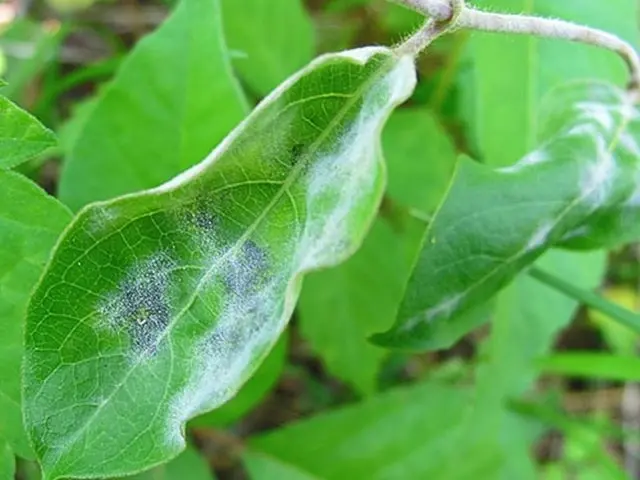
Powdery mildew is easily recognizable by its whitish coating.
Treatment of the disease is carried out with drugs Thiovit, Chistotsvet and other fungicides. The plant is recommended to be sprayed twice or thrice in the spring, before and after flowering.
How to treat cercosporosis on honeysuckle
Cercosporosis is a fungal disease that causes round dots with a red-brown border around the edges to appear on honeysuckle foliage. Cercosporosis leads to a gradual drying of the leaves, while black fungal spores appear in the middle of the dark dots.

Cercosporosis appears as brown spots with a reddish border
To cure honeysuckle leaf disease, it is necessary to treat it Fundazol or copper sulfate. Spraying is carried out in early spring, and then repeated twice more shortly before and after flowering. All shoots affected by the disease must be removed so that the spores of the fungus do not spread to healthy areas.
Rust treatment on honeysuckle
In mid-summer, the shrub is often affected by rust, a disease that causes red-orange spots to appear on the foliage. Rust spreads especially quickly in conditions of high humidity. Honeysuckle changes its color, the processes of photosynthesis in the plant are disturbed, premature leaf fall occurs.

The appearance of rust is indicated by browning of the leaves.
When rust appears on a shrub, it is necessary to immediately remove the affected parts and process the plant Bordeaux liquid. It is also recommended to inspect the area where the shrub grows and remove grasses or barberries from it, if any grow nearby, they are the main carriers of rust.
Treatment of mottled leaves of honeysuckle
Viral mottle is a honeysuckle disease that is provoked by nematode pests. Symptoms of mottling are spots and dots on the foliage of a shrub, usually they have an uneven arcuate shape. Mottling causes serious harm to the health of the shrub, honeysuckle begins to dry and sheds leaves, its endurance and fruiting volumes decrease.
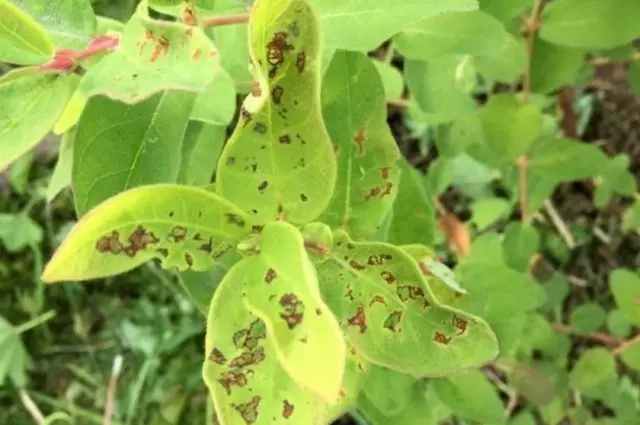
Mottling is manifested by uneven spots on the foliage
Mottle can be cured by treating with fungicides, for example, Fundazol, copper sulfate, Bordeaux liquid. All affected shoots must be completely cut off. It will not be possible to restore their health, but the fungus from them can spread to healthy leaves.
Ordinary cancer
A very dangerous disease for honeysuckle is an ordinary cancer that affects the bark on the trunk and shoots of the plant. Cancer is manifested by deep wounds on the body of the bush, ulcers have sagging along the edges, which sometimes coalesce and form cracks. As the honeysuckle grows, the cracks in its bark widen, and deeper ulcers gradually form, from which the wood of the trunk and shoots dries out.
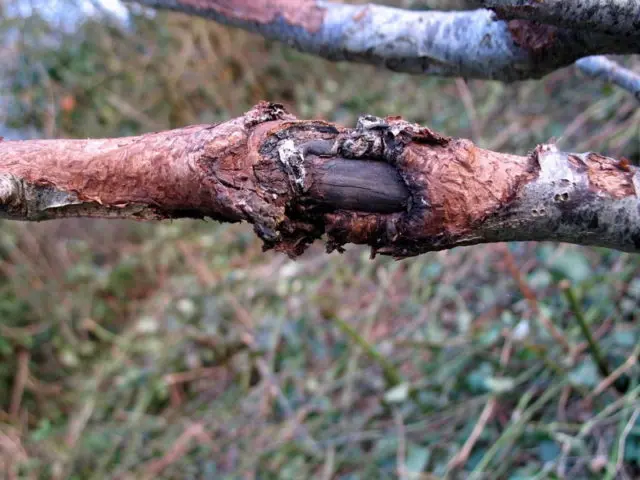
Ordinary cancer affects the trunk of a plant and leaves ulcers on it
Symptoms of ordinary cancer usually appear in the summer, the disease spreads quite quickly to neighboring parts. To prevent the death of the shrub, you must immediately cut off all branches affected by cancer. Healthy parts of the plant are treated with Bordeaux liquid, sections on a tree trunk smeared with oil paint or sprayed with copper sulphate.
Ramulariosis
Ramulariasis is another ailment that poses an increased danger to honeysuckle. You can recognize the disease by gray-brown spots of irregular shape with a dark border, they appear in the spring on young leaves of the shrub. As the plant develops, the spots grow in size, in cloudy rainy weather they can become covered with a white coating.

Ramulariasis – an ailment that leaves spots on the leaves of a shrub
When affected by ramulariasis, the foliage of the shrub cannot develop normally and dies off. Since the plant has to devote resources to the formation of new leaves, this weakens the honeysuckle and impairs its health.
If honeysuckle is sick, then the treatment of ramulariasis is carried out using popular fungicides – Fundazol or copper sulfate. The first spraying should be carried out in the spring when the temperature is set at about 15 ° C, it is during this period that the spores of the fungus begin to actively develop. To achieve the best effect, it is recommended to carry out the treatment 2 or 3 more times per season.
Rezuhi mosaic
Rezuhi mosaic is a viral disease of ornamental honeysuckle that occurs on a shrub under the influence of the vital activity of nematode worms. The main symptoms of the disease are a decrease in internodes on honeysuckle and the appearance of numerous side shoots. Although at first glance the shrub is actively developing, its shoots become weaker and thinner, the leaves decrease in size and begin to dry out over time.
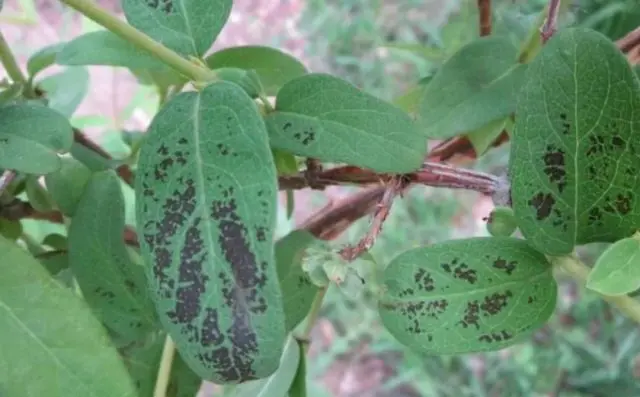
Rezuha mosaic leads to unhealthy shrub growth
Tuberculosis
Drying of honeysuckle shoots, or tuberculosis, is characterized by the appearance of numerous red tubercles with fungal spores on the shoots of the shrub. Already at the beginning of summer, honeysuckle, affected by tuberculosis, withers and sheds leaves, which negatively affects the fruiting and endurance of the plant as a whole. The development of the disease occurs cyclically, at the end of summer, red tubercles with spores form again on the shoots, and the infection of the shrub is repeated again.
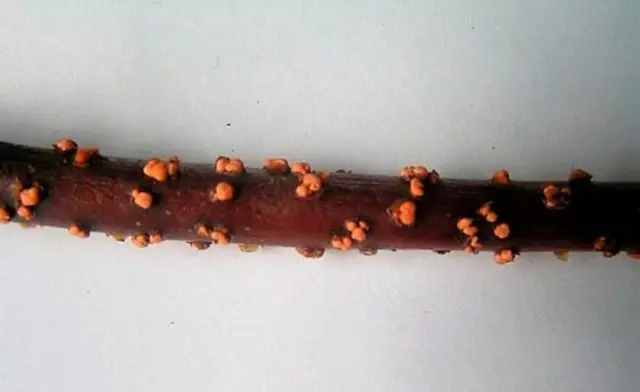
With tuberculosis, small reddish growths appear on the shoots of the plant.
Measures to combat the disease are very simple – all diseased branches need cut and burn. Places of cuts and healthy parts of the plant are treated with Bordeaux liquid and copper oxychloride to prevent a new round of the disease.
Honeysuckle freezer
Honeysuckle is moderately frost tolerant and often suffers from recurrent frosts in the spring. Sharp cold snaps during the period of active vegetation lead to the fact that the bark of the shrub cracks and bursts, wounds remain on the trunk and shoots in which the saprotrophic fungus settles. As a result, a dark coating forms on the surface of the wounds, negative processes begin, and the shoots of the plant dry up and die.
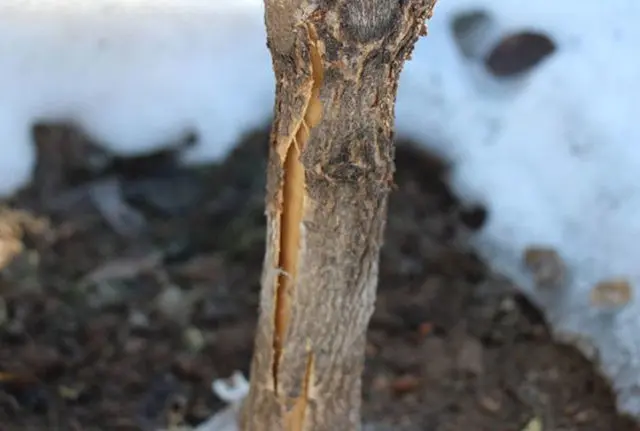
Frost cracks are called cracks on the trunk of a bush
It is very difficult to completely prevent diseases of the honeysuckle trunk. If frost holes appeared after spring frosts, then it is recommended to remove the affected branches completely. If the bush has suffered seriously, and it is impossible to carry out a full sanitary pruning, then the frost holes must be processed Bordeaux liquid after flowering.
Honeysuckle pests and their control
For honeysuckle, not only fungal diseases are dangerous, but also harmful insects. Pests that have settled on the leaves and branches of a shrub can seriously disrupt its vital processes and lead to a weakening of the plant.
How to treat honeysuckle from aphids
Honeysuckle aphid is a dangerous pest that can quickly destroy shrubs. Usually, 2 types of aphids can be observed on honeysuckle:
- apical – the insect infects the tops of the shoots, the leaves curl and the growth of the plant stops;
- green – such aphids spread throughout the shrub evenly and feed on the juices of the leaves.
Symptoms of honeysuckle pests in the spring are yellowing and curling of the leaves. On closer examination, small green or grayish insects can be seen on the leaf plates. Aphids usually appear in early summer, the second wave of infection occurs in early July.
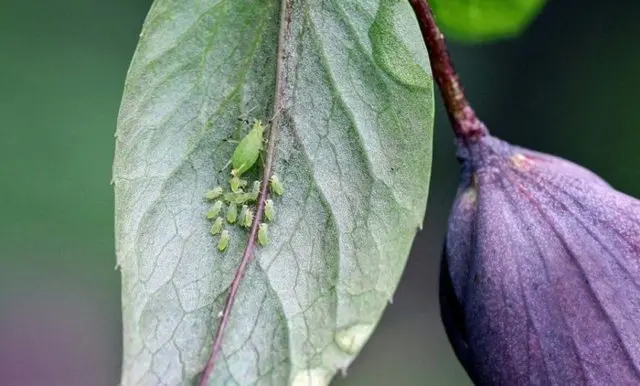
Aphids with a strong spread can destroy the entire green mass
Pest control is carried out with the help of insecticidal preparations – White, Rogora and others. It is best to prophylactically treat the shrub in early spring, before the buds appear, in order to eliminate the pest larvae. Summer processing from aphids brings low results, it is quite difficult to eliminate insects with a massive infection.
How to process honeysuckle from scale insects
Scale insects of various species are a common pest of most berry bushes. They also affect honeysuckle, usually infection occurs in the spring with the arrival of heat, when the pest larvae wake up.
The adult scale insect is a small insect with a hard shell-shield, hence the name. Pests settle mainly on the lower surface of the foliage and at the places where the cuttings are attached to the branches. Since the scale insect draws vital juices from leaves and shoots, honeysuckle quickly weakens under its influence and begins to lose its green mass.
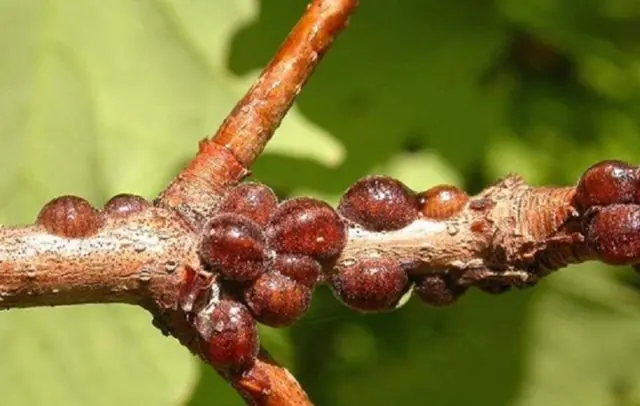
Shchitovka draws juices from the shoots and leads to the death of the bush
You need to fight the scale insects with the help of insecticides Actellik or Rogor. Processing is carried out in the middle of summer, it is necessary to spray the shrub twice with a break of 14 days. Also, the spring preventive spraying of the shrub will not hurt, it will allow you to cope with the pest even at the larval stage.
honeysuckle mite
If the honeysuckle grows in the shade and at high humidity, then the shrub often infects the honeysuckle mite. You can recognize this pest by uneven spots on the lower surface of the leaves and by the browning of the foliage closer to August. Infection with a honeysuckle mite leads to the fact that the edges of the leaf plates are first deformed, a dark coating appears on the surface of the leaves, and then the crown of the shrub simply falls off.
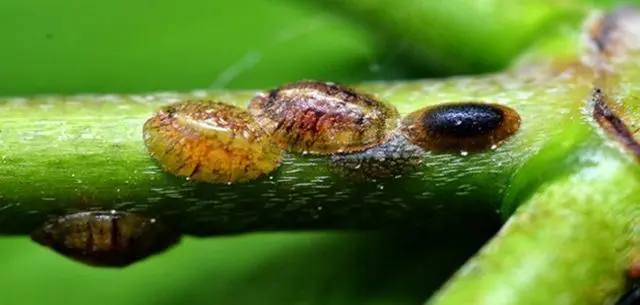
Mite pests lead to browning and leaf fall
Honeysuckle mites can be eliminated with the help of special solutions – Actellica, Mauritius, Thedione and others. The first spraying should be carried out in June, then the honeysuckle should be treated twice more before the end of the growing season.
honeysuckle fingerwing
The development of the honeysuckle shrub in the garden is harmed by the finger-wing, a small gray butterfly whose caterpillars feed on the fruits of the plant and even its bones. The honeysuckle fingerwing causes damage mainly to the crop, the fruits darken, shrivel, do not ripen to the end and crumble to the ground due to its effect.

Fingerwing pest eats developing honeysuckle fruits
You can bring out the honeysuckle fingerwing with the help of the Inta-Vir solution, which is safe for ripening ovaries, and with the help of homemade tinctures on the tops of potatoes and tomatoes. Aggressive insecticidal preparations are not recommended for saving honeysuckle fruits. The crop after such spraying will become unfit for consumption, and in any case, you will have to say goodbye to it.
Rozannaya Torturer
The leaf roller is a small brown butterfly that lays its eggs on the bark and leaves of honeysuckle. Caterpillars hatched from eggs feed on the juices of foliage, buds and shoots, wrapping the damaged areas of the bush in a light cobweb in the process of life. If left unchecked, the leafworm can seriously damage the honeysuckle and destroy the green parts of the shrub.

Rosan leaflet is able to destroy the green mass of honeysuckle bushes
Insecticides help well against leafworm pests. Actellik and Elesar. It is recommended to process planting several times per season. The first spraying should be carried out in late April or early May in order to immediately eliminate most of the awakened larvae.
How to treat honeysuckle in the spring from pests and diseases
Different pests and fungal diseases of honeysuckle manifest themselves at different times. Some diseases begin to develop with the establishment of heat, the symptoms of others appear only in the middle or end of summer.
To protect honeysuckle from pests and diseases, it is customary to carry out annual preventive treatment. It is carried out in the spring, at a time when stable temperatures above 5 ° C have been established, but the buds have not yet begun to bloom. Usually, several sprays are carried out during the spring and summer, this allows you to eliminate the larvae of most pests and fungal spores:
- It is allowed to spray honeysuckle with any garden insecticides and fungicides. The most well-proven remedies are Actellik, Fundazol, Bordeaux liquid and copper sulfate, Aktara and others.
- With a weak damage to honeysuckle by pests, you can also use home remedies, for example, a regular soap solution.
- It should be borne in mind that with a neglected lesion, folk remedies may not bring results.
After the first preventive spraying in early spring, the procedure is recommended to be repeated 2 or 3 more times to achieve maximum results. It should be borne in mind that it is impossible to spray honeysuckle directly during flowering, chemicals can disrupt the pollination process.
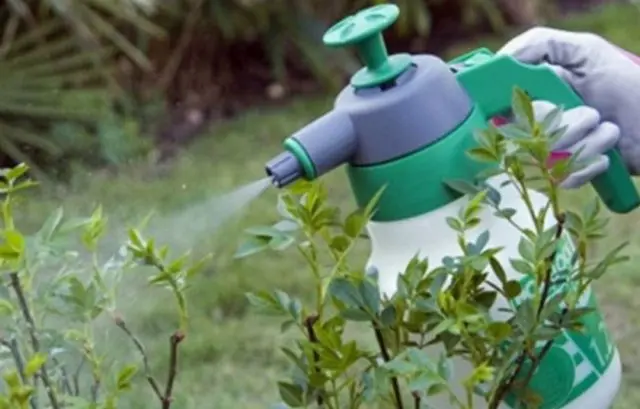
You can spray the bushes not only with chemicals, but also with boiling water.
Some gardeners also treat honeysuckle with boiling water in the spring. It is performed immediately after the snow melts, and before the buds open, the roots of the shrub are covered with dense material, and the ground part of the bush is poured with hot water. This treatment eliminates most of the larvae and fungal spores in the bark.
To protect honeysuckle from diseases and pests, it is important to carefully monitor the sanitary condition of the garden. Every spring, the honeysuckle shrub is inspected for damage and dry, broken, twisted branches are removed in a timely manner. With thickening of the bush and the presence of diseased shoots, the likelihood of developing fungal diseases greatly increases.
Conclusion
Pests and diseases of honeysuckle and their control is a topic that every gardener should be familiar with. Regular inspections of the shrub, as well as spring preventive treatment, can protect honeysuckle from damage and prevent the development of diseases.









